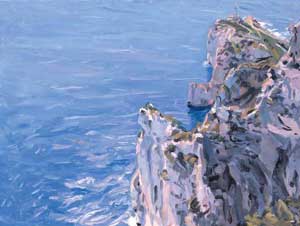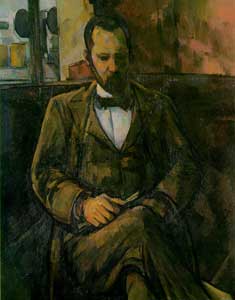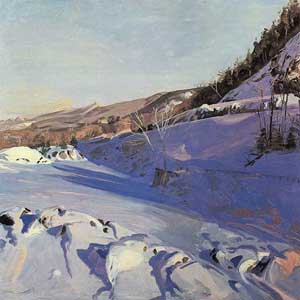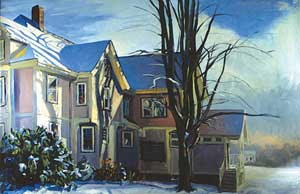
George Nick Punta Carena, Capri 1993 oil on linen 28 x 38 inches
Interview with George Nick Part Four, On Cezanne and color
Larry Groff:
You’ve often talked about Cézanne in color. You said something like, “Painting from nature is not copying the object. It is realizing one’s sensations.”
Can you speak about how Cézanne has influenced your painting? In particular, I’m curious about what you think about Cézanne’s ideas on getting the right color sensations from nature.
George Nick:
Well, I don’t know if I agree with some of the things you’re saying. But you’ve asked, so, let’s go into it.
First of all, it begins with my training and this is such a superficial thing. His influence on me was when I start painting, I start with a blue wash. You know how all his paintings have a blue wash, how he starts drawing in blue, and the water colors stuck out blue? Well, that’s one way he’s influenced me. I refuse to start a painting with any other color.
LG:
Okay. I always wondered about that.
George Nick:
Well, I just thought it was as trivial as you can get, but it’s one of those things that stuck, that’s all.
He said, “Nature is not copying the object, it’s really realizing one’s sensations.” He also said that he’s painting his “little thrills.” Do you remember that one?
LG:
Yes.
George Nick:
Well, the combination is important, because what he’s getting from nature is how to draw, how to make form, how to make space, and how to make the generic quality of the subject. So, how do you make form? Well, you look at light and you make light and dark, and you get a good color.
But what’s shocking to me, always has been, is I think the only paintings he’s signed are the ones he considered he had finished, and there’s very few of those, that [are] signed. So I think everything he did was unfinished and in [the] process of development.
It’s like the painting that he did of Vollard. He did a portrait in the ’90s, I think, that took ninety-two sessions, and at the end of ninety-two sessions — I’m not sure I’m accurate with this, he asked Vollard if he would leave him his shirt and coat, so he could continue the painting.
So he continued it, and later on, when they were looking at the painting, he was talking to somebody, he said, “How do you like the painting?”
He said, “Well, there’s a spot on the shirt I like.”

CézannePortrait of Ambroise Vollard 1899 oil on canvas 39 x 32 inches
George Nick:
So talk about severity and unhappiness. I think he was never satisfied. That’s why he’s forever changing and trying to grow out of the bad, or unrealized paintings he was making all the time. I think he was improving.
The business about copying — that’s why I think he gets out of nature, is what he gets out of life — is to realize it, to realize that on canvas, you’ve got these fundamental problems that are three-dimensional versus two-dimensional, and how do you construct marks in color to construct a form convincingly, and make the big lie. So it’s realizing one’s sensations.
Well, I think this is where the thrill comes in. I think you realize a sensation when you try to get as honest as you can, and the painting is ugly, or the color is ugly, or the color is not working well enough. The form is not working well enough. I think when you get the color right, and you like it better, you succeed in both making the form and the space and the object.
So I think that’s what realizing one’s sensations means, is it’s all transcribed through your emotions and your intellect at the same time. You’re thinking, and you’re emoting, if there’s such a word.
And I’ve been thinking about that for a long term, and I always think about how to construct things, because I think from Delacroix he got the idea, and the Impressionists, how to apply paint; and then he got involved with studying nature and the application began to bend towards what he was looking at. So he got away from Impressionism and he got into a more personalized activity, which was at the same time, constructing the form, going with the form, and making it the object — which is kind of hard to talk about. I think that’s what he did.
Because the Pointillism was the more avant-garde method of painting, and a much colder method of painting, because it’s a system, like Seurat. But Seurat made it even crazier than the Impressionists, because he was more severe about it.
But I think Cézanne’s wiggly marks, really have a lot to do with his character, but also with the description of the trees and the spaces and the leaves and the rocks and the crevices, and all that kind of stuff.
If you look at the drawings, they’re really amazing. He’s really involved with making geometric forms out of organic forms, and he feels that geometric beauty is the way to describe the world. It’s like Scopas, the Greek sculptor, who was in that same kind of mode, and thinking like that.
If you look at his drawings, they’re really amazing. Everything has these curves. At no time that it doesn’t make a geometric form, no matter how wiggly he gets. There’s always some sort of rhythm to the curve. It falls into a geometry that’s very severe, and he transcribes all of nature that way.
LG:
Are you familiar with Erle Loran’s book, Cézanne’s Compositions?
George Nick:
Oh, God, is that the one that has all these arrows, and points out which way they’re moving, and all that stuff?
LG:
Well, it also has photographs he took in the 1920s of Cézanne’s motifs and compares paintings with the actual scenes…
George Nick:
And how they’re bent, how they’re leaning, right?
LG:
Right.
George Nick:
The paintings are. Well, I think it’s surprising. If you look at the way he started a painting, he would put one mark on one part of the painting, and another mark on another part of the painting, another mark, another part of the painting, and they’re all connected in the end, which is [an] amazing kind of three-dimensional chess.
I think he had an immense ability of absorbing the whole theme, and transcribing it, within his emotions. The painter that he painted early, with the long face — I forgot the name of that artist — there was a distortion to it, but it was distorted from the beginning. He added in this line, like when he did a building on the side of a road, and it’s leaning, and this and that. You look at the photograph, and the photograph doesn’t look like that. Why did he do that?

George Nick Over Pemigewasset River 1986 oil on linen 40 x 40 inches
George Nick:
I never could find an answer, why he did it. All I know is that he really did it, but he did it from the beginning, from the inception of putting down the first mark, because he controlled the whole scene. It’s a remarkable achievement, the way he made paintings.
How did all the paintings connect correctly? I think it’s phenomenal, that’s all. I’ve never been able to understand it. One of those geniuses, that thinks his own way, and that was the way that he sorted things out.
Now what was this last sentence? I’m curious what you think about Cézanne’s ideas on getting the right color sensations from nature? What does that mean? What do you mean by that, that he got the right color sensations from nature? How do you know they’re right? How do you know he got the right one?
LG:
Well, I guess, right for him. He talked a lot about wanting to get the correct color sensation of what he was seeing. He was struggling with that.
George Nick:
Well, you know what he’s doing? He’s putting a painting together. It has to be right in two ways: it has to be right because it has to be convincing, as being part of the object, and it has to be right in fitting together with the rest of the painting. So that’s another miracle.
So that’s what he means about being right. It has to work together, and colors have to help each other in the painting. So that’s what I think you’re suggesting, you’re talking about.
LG:
It also seems like it has to work for him; like say, Pissaro, painting along next to him, might get a very different color for the same thing, and they would both be right, for each painter.
George Nick:
Well, I don’t know if he felt that Pissaro was right, but I don’t know if he ever felt that he was right, that he was aiming for something that was trying to be honest.
LG:
Right. Honest is probably a better word than right.
George Nick:
Yes, they’re both sensations in nature. Yes, being honest.
LG:
The colors in your paintings seem dead-on, very specific and carefully observed. You’ve said in the past you would go to great lengths, returning day after day, over many sittings, to get the exact color, never settling for an approximation.
Your friend, the late John Updike, said of your color, “He omits without giving an effect of omission. His attention, like a quietly singing shuttle, collects harmonious patches of surprisingly true color – color with a clear conscience.”
Can you speak to the importance of this integrity, in getting the right color in your work?
George Nick:
Using the words, right color, again. I really don’t like that phrase.
LG:
Which phrase?
George Nick:
Right color. Because I struggled for a long time …
LG:
Ah. I should say good color. I can change it to good color. It’s not too late.

George Nick Approaching Storm 2002 oil on linen 40 x 60 inches
George Nick:
Well, whatever. No, you said that, and I’m talking about it, that’s all.
This is what I feel about being dead-on. Once I was painting this house outside, for about a couple of weeks, and this little boy came up to me, and said, “How come you’re not painting the color of the house?”
So I thought that his eye, from a little kid, can see that I’m not using the same color or the correct color or the right color. So what am I doing? I’m trying to make a painting. I don’t intentionally go about it; it just keeps moving that way.
I think Dickinson said once, that if you can make a color in a day, you’re doing pretty well. That’s pretty good. It’s not an easy job.
It’s the same thing [when] Stravinsky said to the border guard in 1914 at the Swiss Border when they asked him “What’s your profession?” He said he’s an inventor.
George Nick:
And then he called his son later. His son said, “Why did you say that?”
He said, “Well, I invent sounds. That’s what I do.”
I feel the same way about invention. I have to find a new color every day. I find a new relationship every day. It means something, to be honest with my feelings, and not being bored; but in finding something that is carefully observed through observation is leading me to making a worthwhile effort, by being exact.
If it isn’t exact, it’s positive. It states itself like it’s light. It doesn’t mean it is light. It’s like I tell my students, sometimes, “Make believe you know what you’re doing, and that confidence brings out something that gives you a lot of energy, and a lot of gusto, and a lot of action.”
You’ve said an Impressionist goes to great lengths to get the exact color, never settling for an approximate. Well, I think I cheated a very few times, and I think we’re going to talk later about the horse painting, and it will come out there what I really think about the color.
But about Updike, I don’t understand. He had very kind words to say about me, but I still don’t understand the business of conscience. I think he felt that I was trying to hold up with integrity of an idea of how to get about — maybe, I think — that’s how he attributes this to a conscience, a good conscience or something.
That’s why the integrity seems to be important. I change a color to make it better. It is only better if it is closer to what I fitted in the painting and was to the object. My painting concerns stimulation of nature, and nature gives out a lot of things. It’s like Cézanne saying, “There’s nothing to paint in the world. It’s all gray.” And it is. There’s ugly, awful stuff out there. How do you make a painting out of it?
I think you have to dig pretty deep in these things, without making monochromatic nonsense, and having color as an important function of the painting, an important part of expression.
[podcast]http://gnick_interview.s3.amazonaws.com/georgeNickintervAll.mp3[/podcast]To Interview with George Nick, Part One, On Edwin Dickinson
To Interview with George Nick, Part Two, On Fairfield Porter
To Interview with George Nick Part Three, On George Bellows
To Interview with George Nick Part Four, On Cezanne and color
To Interview with George Nick Part Five, On Drawing
To Interview with George Nick Part Six, On The Trojan Horse and thoughts on Teaching





George Nick said: If it isn’t exact, it’s positive. It states itself like it’s light/RIGHT. It doesn’t mean it is light/Right. It’s like I tell my students, sometimes, “Make believe you know what you’re doing, and that confidence brings out something that gives you a lot of energy, and a lot of gusto, and a lot of action.”
I think he meant /right instead of /light in the context of what he was saying before that he didn’t like that word but you asked and he was explaining it in that way…but not really sure.
Light Cézanne said was expressed with colour or in his own words… It is impossible to reproduce light; it must be represented by something else, by colours.
Anyways thanks for this nice interview with George Nick. Much appreciated.
TDK, I think he also meant he disagreed with my talking about the right color as if there was one right color for any observed phenomena – like the exact munsell color notation or something. I misspoke – I meant more the right color for the situation that makes the painting work as a whole. Naturally, making the painting work can also mean achieving the best expressive response to what you’re painting. I agree with what you’re saying here about light and what you are telling your students.
Larry thank you for this interview. I think I already said somewhere (maybe in this very blog) that IMO most (good) painters are better at painting than at describing the process, in both intellectual /emotional part and in physical manipulation of paint.
That does not mean that they are lesser painters for it, just that sometimes some things that they say sound (to me) strange or hard to believe.
Hi Larry, Munsell now that is something I never really understood but each is left to their own devices to do what they please, I guess. I just don’t understand how that act of picking notations can be accomplished well when you’re in the act of being honest and trying to be expressive with colour. Munsell it seems at least to me, to be anti productive or it would slow the whole train of thought down to a mere academic exercise.
I get this sense that the result of a desired colour will be mostly an extension of being uniquely human or the desired colour can be the result of a protracted feel, sensibility, temperament etc of the artist. Of course there’s going to be mistakes along the way and as he says the chess game continues but eventually we arrive at something with a greater sense of being honest and hopefully that will show in the end result. Well anyways that’s what I am taking away from this good interview with George Nick.
There are many quotes about why it could be important for some to be honest but one of my favorites is “Beauty is truth, truth beauty…. that is all ye know on earth and all ye need to know.” – John Keats
Oh, I also liked that he alluded to INVENTION which is validation for me. So it was nice to hear that as well. Good stuff. ?
I had a smiley face at the end of my comments, not sure why it came up as a question mark. Just letting you know because it looks weird.
I especially like the part about starting with a blue base. I think every artist has their own beginning point they feel most comfortable with, but you rarely hear about it.
hi i`m juan carlos camacaro from Venezuela, i think that the true artist can do with an real intelectual touch , Cezanne works until now have an higth vigency and every places of the word is an theme for study… never forget it… he was a genius…
Welcome Juan Carlos. Every time I look at Cezanne or read his writings I find something new that inspires me to find my own directions. He is a great source.
Thanks for writing
oh sorry my english is not very well